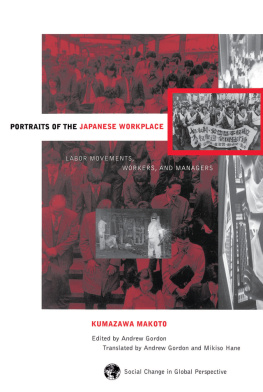Portraits of the Japanese Workplace
Social Change in Global Perspective
Mark Selden, Series Editor
Exploring the relationship between social change and social structures, this series considers the theory, praxis, promise, and pitfalls of movements in global and comparative perspective. The historical and contemporary social movements considered here challenge patterns of hierarchy and inequality of race, gender, nationality, ethnicity, class, and culture. The series will emphasize textbooks and broadly interpretive synthetic works.
Portraits of the Japanese Workplace
Kumazawa Makoto
Power Restructuring in China and Russia
Mark Lupher
The Transformation of Communist Systems: Economic Reform Since the 1950s
Bernard Chavance
The Challenge of Local Feminisms: Women's Movements in Global Perspective edited by Amrita Basu, with the assistance of C. Elizabeth McGrory
Forthcoming
African Women: A Modem History
Catherine Coquery-Vidrovitch
Portraits of the Japanese Workplace
Labor Movements, Workers, and Managers
Kumazawa Makoto
Translated by Andrew Gordon and Mikiso Hane
Social Change in Global Perspective
First published 1996 by Westview Press
Published 2018 by Routledge
711 Third Avenue, New York, NY 10017, USA
2 Park Square, Milton Park, Abingdon, Oxon OX14 4RN
Routledge is an imprint of the Taylor & Francis Group, an informa business
Copyright 1996 Taylor & Francis
All rights reserved. No part of this book may be reprinted or reproduced or utilised in any form or by any electronic, mechanical, or other means, now known or hereafter invented, including photocopying and recording, or in any information storage or retrieval system, without permission in writing from the publishers.
Notice:
Product or corporate names may be trademarks or registered trademarks, and are used only for identification and explanation without intent to infringe.
Library of Congress Cataloging-in-Publication Data
Kumazawa, Makoto, 1938
Portraits of the Japanese workplace: labor movements, workers,
and managers / by Kumazawa Makoto. p. cm. (Social change in global perspective)
Translated from Japanese.
Includes bibliographical references and index.
ISBN 0-8133-1709-6 (hc). ISBN 0-8133-1708-8 (pb)
1. Industrial relationsJapan. 2. Industrial managementJapan.
3. Labor movementJapan. 4. Trade-unionsJapan. 5. Women
EmploymentJapan. 6. Work environmentJapan. I. Title.
II. Series: Social change in global perspective (Boulder, Colo.)
HD8726.5.K772 1996
331'.0952dc20 96-15010
CIP
ISBN 13: 978-0-8133-1708-3 (pbk)
"Feudal," "backward," "distorted." Readers aware of the recent worldwide enthusiasm to learn the secrets of labor and production management from Japan may find this surprising, but for much of the postwar era, Japanese economists, sociologists, journalists, and activists used these terms to describe wage laborers and labor-management relations in their country. And if Japan was backward, these critics argued, workers as well as managers in the West offered models to which Japanese people should aspire. When speaking of organized labor in particular, they posed British unionism and European social democracy as models of thought and behavior against which workers in Japan were measured and found wanting, and which they were exhorted to emulate.
But beginning in the 1970s, a new body of writing emerged in Japan. It rejected the Eurocentric worship of Western models that had marked much of this earlier discussion of labor. This was largely the work of a younger generation impressed by the appearance of Japanese economic dynamism and Euro-American stagnation, although some scholars of the old school changed to this new tune as well.
The importance of translating this work must first be understood in this context. Kumazawa Makotoresponse to, and partial agreement with, the conclusions of the newer "Japanese-model" school as well.
Though a critical tone certainly dominates his analysis, the social landscape that he describes is not uniformly bleak. Kumazawa recognizes that the dynamism of the Japanese system of labor-management relations helped make possible the extraordinary performance of Japanese industry and economy from the 1950s through the 1980s. He describes the very important gains made by some workers as they participated in this system. But he ultimately returns to a belief that the social costs paid by Japanese working people over the past fifty years have been much too high. As the prolonged recession of the Japanese economy in the early 1990s has led many both in Japan and around the world to question celebratory renditions of the Japanese model (if for reasons of "economic performance" rather than human cost), Kumazawa's thoughtful skepticism makes a renewed claim on our attention.
Kumazawa's work demands attention for another related reason. He is a sociologist writing in a humanistic rather than a scientific tradition. That is, rather than constructing so-called testable hypotheses and seeking to tease out independent and dependent variables to explain "outcomes," he asks what meaning the experience of work held, or holds, for people in Japanese society. He begins the book with a relatively abstract theory of "worker society," but he sets himself apart from many labor scholars in Japan by moving quickly to join theory to the specifically rendered experience of particular individuals and groups of workers. What social values did people seek to realize at the workplace? What were the central features of their past experiences at work, and how, if at all, have these changed more recently? How does workplace experience relate to social life outside the company, to family and community life, to politics and public policy?
As Kumazawa responds to such questions he is always looking for a strategy by which workers themselves might act to improve their conditions or achieve greater control over their lives on the job. This sets him apart from the majority of commentators on the Japanese economy and management who are writing in English, who almost always adopt the perspective of management or the state; they assume that efficiency, productivity, and profit are sacred values and ends in themselves. Kumazawa's perspective is obviously different. He challenges the sacred values of the corporate society, and he asks how working women and men might change workplace society. The result of his critical appraisal is a compelling portrait of working life in contemporary Japan, comparative in perspective and firmly grounded both in an interpretation of the prewar and postwar history of twentieth-century Japan and in a close reading of experience in particular work sites.
Kumazawa's work holds particular importance for readers in the English-speaking world for two further reasons. It challenges the widespread stereotypes that hold that the cultural essence of the Japanese is an inherent docility and a deeply ingrained tendency to put group harmony and the interests of the collectivity ahead of individualistic strivings. Kumazawa neatly stands these images on their heads when he contrasts the fierce man-to-man competition of Japan's worker society (I use the male reference advisedly) with British or American worker cultures in which the interests of the group predominate and in which individuals are socialized to restrict competition for the collective good. The Japanese workers introduced in these pages are, if anything, individualistic to a fault, as they struggle to maintain secure livelihoods and a sense of personal dignity in a competitive workplace environment.










